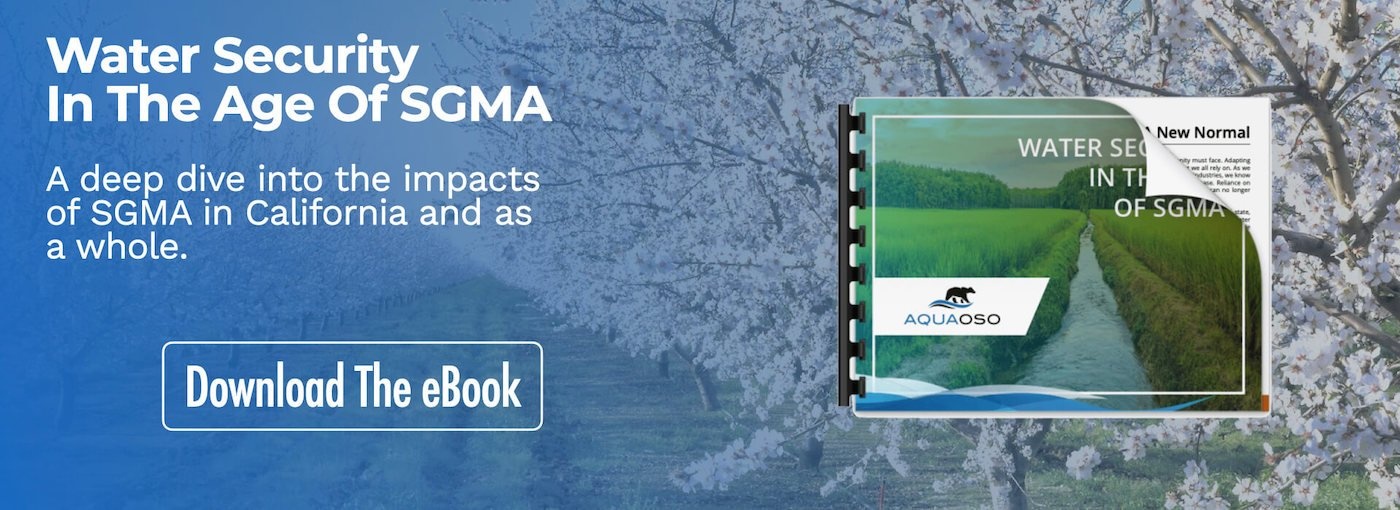We live in a world of water scarcity. By 2030, humanity’s annual global water requirements will exceed current sustainable water supplies by 40 percent. Food production needs, increased urban growth and environmental requirements combined with ongoing extreme weather events will undoubtedly put additional pressure on our water sources. In response to the growing threat of climate change, the California legislature pushed for greater regulation over water resources.
2018 was a busy year for California’s water regulators. Issues related to water supply impacted water risk management in 2018 and continue into the foreseeable future. Understanding the climatic water risk must be done so in the context of policy and regulation. The Sustainable Groundwater Management Act (SGMA) and other water regulation are key aspects of water risk in California.

SGMA
The SGMA’s first major deadline looms for GSAs in critically overdraft groundwater basins on January 31, 2020. Entering the final phases of Groundwater Sustainability Plan drafting, 2018 saw the finalization of most GSA boundaries and an intensive focus on groundwater modeling, budgets, sustainable yields and allocation criteria. Expect draft GSPs to appear and circulate for comment in the next few months. We are creating a blog series to assist with understanding how to pull relevant information from these information packed documents. SGMA’s deadline for critically overdrafted basins is beginning to increase activity by organizations as they buy land, review assets, and participate in stakeholder meetings in anticipation of groundwater pumping restrictions. Additionally, the option to initiate a groundwater adjudication may be exercised in GSAs that are unable to strike a balance between the various stakeholders within their boundary.
One can expect SGMA to drive an increase in groundwater banking, both to improve thresholds for sustainable yields and simply because banked water can be sold at a later date for profit. Understanding how GSAs are regulating groundwater, and who is banking what, where, and how much will inform water risk decisions and shine a light on the problem of long-term overdraft in some of the highest value agricultural regions in the country. Careful planning on augmenting surface water supplies while either drawing very lightly upon, or even replenishing, groundwater is a best practice as we move further into 2019.
Mitigating Water Risk
AQUAOSO Technologies recently partnered with ASFMRA to provide a free water map to assist the community in identifying, understanding, and monitoring water risk. When analysis indicates water supplies are low, and poor conditions are likely to occur, a mitigation strategy is needed. One interesting development linked to the implementation of the SGMA is the power of a GSA to facilitate groundwater transfers within its boundaries, such as conjunctive use programs that utilize the exchange of water between surface and groundwater supplies to balance agricultural need and groundwater basin health. We may also see groundwater credits and surface water markets take hold in California allowing flexibility in water management as swings in climate continue to disrupt water management strategies.
Advanced technologies allow for the increased collection and analysis of data that is required for flexible water management solutions such as conjunctive use programs and water markets. Under California Water Code Section 1011.5(a), the state declares, “policy of this state to encourage conjunctive use of surface water and groundwater supplies and to make surface water available for other beneficial uses.” Conjunctive use contemplates using water supplies only when needed, which made water right holders uneasy due to concerns over forfeiture or diminishment of their water rights for nonuse. However, the legislature ensures participants in conjunctive use programs would not forfeit or diminish their surface water rights by relying on stored groundwater.
The legislature allows water that is saved as a result of conjunctive use program to be “sold, leased, exchanged, or otherwise transferred” if it complies with laws governing transfers. As a management tool, it allows flexibility in utilizing surface and groundwater to meet users’ needs and is an inexpensive way to store groundwater or reserve surface water in a stream for various beneficial uses.
A better picture of water risk and the ability to move water between surface and ground will allow water markets to base their operations on solid data. Water markets offer a flexible water management solution for water districts, GSAs, and water right holders to move water when needed and provide an economic incentive for doing so. Having the programs and agreements in place prior to major swings in precipitation can effectively mitigate many risks that continue to threaten California agriculture.
Proactive Approach
The most important lesson to learn from the threat of Climate Change, new regulation, and new water management strategies is to be proactive. Exploring data, technology, and existing partnerships is one way to take active steps towards adapting your organization to the new realities of climate change. AQUAOSO has the tools you need to augment your efforts to build water resiliency into your portfolio and long-term business strategies.
